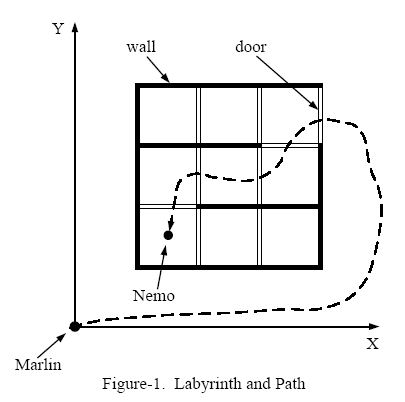Finding Nemo(bfs)
| Time Limit: 2000MS | Memory Limit: 30000K | |
| Total Submissions: 6988 | Accepted: 1600 |
Description
After checking the map, Marlin found that the sea is like a labyrinth with walls and doors. All the walls are parallel to the X-axis or to the Y-axis. The thickness of the walls are assumed to be zero.
All the doors are opened on the walls and have a length of 1. Marlin cannot go through a wall unless there is a door on the wall. Because going through a door is dangerous (there may be some virulent medusas near the doors), Marlin wants to go through as few doors as he could to find Nemo.
Figure-1 shows an example of the labyrinth and the path Marlin went through to find Nemo.

We assume Marlin's initial position is at (0, 0). Given the position of Nemo and the configuration of walls and doors, please write a program to calculate the minimum number of doors Marlin has to go through in order to reach Nemo.
Input
Then follow M lines, each containing four integers that describe a wall in the following format:
x y d t
(x, y) indicates the lower-left point of the wall, d is the direction of the wall -- 0 means it's parallel to the X-axis and 1 means that it's parallel to the Y-axis, and t gives the length of the wall.
The coordinates of two ends of any wall will be in the range of [1,199].
Then there are N lines that give the description of the doors:
x y d
x, y, d have the same meaning as the walls. As the doors have fixed length of 1, t is omitted.
The last line of each case contains two positive float numbers:
f1 f2
(f1, f2) gives the position of Nemo. And it will not lie within any wall or door.
A test case of M = -1 and N = -1 indicates the end of input, and should not be processed.
Output
Sample Input
- 8 9
- 1 1 1 3
- 2 1 1 3
- 3 1 1 3
- 4 1 1 3
- 1 1 0 3
- 1 2 0 3
- 1 3 0 3
- 1 4 0 3
- 2 1 1
- 2 2 1
- 2 3 1
- 3 1 1
- 3 2 1
- 3 3 1
- 1 2 0
- 3 3 0
- 4 3 1
- 1.5 1.5
- 4 0
- 1 1 0 1
- 1 1 1 1
- 2 1 1 1
- 1 2 0 1
- 1.5 1.7
- -1 -1
Sample Output
- 5
- -1
- #include<stdio.h>
- #include<string.h>
- #include<queue>
- using namespace std;
- int n,m,ex,ey;
- int map[][],vis[][];
- struct node
- {
- int x,y;
- int step;
- bool operator<(struct node b)const
- {
- return step > b.step;//按步数从小到大排序,每次取队列中步数较小的;
- }
- };
- priority_queue <struct node> que;
- int bfs()
- {
- while(!que.empty())
- que.pop();
- que.push((struct node){,,});//从终点到起点
- vis[][] = ;
- while(!que.empty())
- {
- struct node u = que.top();
- que.pop();
- if(u.x == ex && u.y == ey)
- return u.step;
- if(map[u.x-][u.y] != && !vis[u.x-][u.y])
- {
- vis[u.x-][u.y] = ;
- if(map[u.x-][u.y] == )
- que.push((struct node){u.x-,u.y,u.step});
- else que.push((struct node){u.x-,u.y,u.step+});
- }
- if(map[u.x+][u.y] != && !vis[u.x+][u.y])
- {
- vis[u.x+][u.y] = ;
- if(map[u.x+][u.y] == )
- que.push((struct node){u.x+,u.y,u.step});
- else que.push((struct node){u.x+,u.y,u.step+});
- }
- if(map[u.x][u.y-] != && !vis[u.x][u.y-])
- {
- vis[u.x][u.y-] = ;
- if(map[u.x][u.y-] == )
- que.push((struct node){u.x,u.y-,u.step});
- else que.push((struct node){u.x,u.y-,u.step+});
- }
- if(map[u.x][u.y+] != && !vis[u.x][u.y+])
- {
- vis[u.x][u.y+] = ;
- if(map[u.x][u.y+] == )
- que.push((struct node){u.x,u.y+,u.step});
- else que.push((struct node){u.x,u.y+,u.step+});
- }
- }
- return -;
- }
- int main()
- {
- int x,y,d,t;
- while(~scanf("%d %d",&n,&m))
- {
- int i;
- if(n == - && m == -)
- break;
- //1表示墙,2表示门,3表示空气
- memset(map,,sizeof(map));
- memset(vis,,sizeof(vis));
- while(n--)
- {
- scanf("%d %d %d %d",&x,&y,&d,&t);
- if(d == )
- {
- for(i = y*; i <= (y+t)*; i++)
- map[x*][i] = ;
- }
- else
- {
- for(i = x*; i <= (x+t)*; i++)
- map[i][y*] = ;
- }
- }
- while(m--)
- {
- scanf("%d %d %d",&x,&y,&d);
- if(d == )
- map[x*][y*+] = ;
- else
- map[x*+][y*] = ;
- }
- double e_x,e_y;
- scanf("%lf %lf",&e_x,&e_y);
- if(e_x < || e_y < || e_x > || e_y > )
- {
- printf("0\n");
- continue;
- }
- ex = (int)e_x*+;
- ey = (int)e_y*+;
- for(i = ; i <= ; i++)
- map[i][] = map[][i] = map[][i] = map[i][] = ;
- printf("%d\n",bfs());
- }
- return ;
- }
Finding Nemo(bfs)的更多相关文章
- 深搜(DFS)广搜(BFS)详解
图的深搜与广搜 一.介绍: p { margin-bottom: 0.25cm; direction: ltr; line-height: 120%; text-align: justify; orp ...
- 【算法导论】图的广度优先搜索遍历(BFS)
图的存储方法:邻接矩阵.邻接表 例如:有一个图如下所示(该图也作为程序的实例): 则上图用邻接矩阵可以表示为: 用邻接表可以表示如下: 邻接矩阵可以很容易的用二维数组表示,下面主要看看怎样构成邻接表: ...
- 深度优先搜索(DFS)与广度优先搜索(BFS)的Java实现
1.基础部分 在图中实现最基本的操作之一就是搜索从一个指定顶点可以到达哪些顶点,比如从武汉出发的高铁可以到达哪些城市,一些城市可以直达,一些城市不能直达.现在有一份全国高铁模拟图,要从某个城市(顶点) ...
- 【BZOJ5492】[HNOI2019]校园旅行(bfs)
[HNOI2019]校园旅行(bfs) 题面 洛谷 题解 首先考虑暴力做法怎么做. 把所有可行的二元组全部丢进队列里,每次两个点分别向两侧拓展一个同色点,然后更新可行的情况. 这样子的复杂度是\(O( ...
- 深度优先搜索(DFS)和广度优先搜索(BFS)
深度优先搜索(DFS) 广度优先搜索(BFS) 1.介绍 广度优先搜索(BFS)是图的另一种遍历方式,与DFS相对,是以广度优先进行搜索.简言之就是先访问图的顶点,然后广度优先访问其邻接点,然后再依次 ...
- 图的 储存 深度优先(DFS)广度优先(BFS)遍历
图遍历的概念: 从图中某顶点出发访遍图中每个顶点,且每个顶点仅访问一次,此过程称为图的遍历(Traversing Graph).图的遍历算法是求解图的连通性问题.拓扑排序和求关键路径等算法的基础.图的 ...
- 数据结构与算法之PHP用邻接表、邻接矩阵实现图的广度优先遍历(BFS)
一.基本思想 1)从图中的某个顶点V出发访问并记录: 2)依次访问V的所有邻接顶点: 3)分别从这些邻接点出发,依次访问它们的未被访问过的邻接点,直到图中所有已被访问过的顶点的邻接点都被访问到. 4) ...
- 层层递进——宽度优先搜索(BFS)
问题引入 我们接着上次“解救小哈”的问题继续探索,不过这次是用宽度优先搜索(BFS). 注:问题来源可以点击这里 http://www.cnblogs.com/OctoptusLian/p/74296 ...
- HDU.2612 Find a way (BFS)
HDU.2612 Find a way (BFS) 题意分析 圣诞节要到了,坤神和瑞瑞这对基佬想一起去召唤师大峡谷开开车.百度地图一下,发现周围的召唤师大峡谷还不少,这对基佬纠结着,该去哪一个...坤 ...
随机推荐
- Oracle修改被占用的临时表结构
这两天在修改临时表的类型时,提示”attempt to create,alter or drop an index on temporary table already in use“的错误,由于临时 ...
- 10.30 morning
P75竞赛时间: ????年??月??日??:??-??:?? 注意事项(请务必仔细阅读) [ 问题描述] 从1 − N中找一些数乘起来使得答案是一个完全平方数,求这个完全平方数最大可能是多少.[输入 ...
- hibernate中有时候复杂删除有时候可以拆分为两个语句
这个demo是使用原生的sql语句写的,也就是没有调用我在struts中已经写好的公用类common中的增删改查功能,所以要开启事务
- Android Animation学习 实现 IOS 滤镜退出动画
IOS的用户体验做的很好,其中一点很重要的地方就是动画效果. 最近在学习Android的Animation,简单实现了一个IOS相机滤镜退出的动画: 布局文件:activity_animation_d ...
- Android开发手记(28) Handler和Looper
Android的消息处理有三个核心类:Looper,Handler和Message.其实还有一个Message Queue(消息队列),但是MQ被封装到Looper里面了,我们不会直接与MQ打交道.平 ...
- 使用EMMET中的小坑
使用EMMET写HTML的时候,是一个非常爽的事情.但是今天我使用时,发现一个小坑.以前倒也没有注意,不过需要非常的小心. form[action="/process" metho ...
- Android布局管理器(表格布局)
表格布局有TableLayout所代表,TableLayout继承了LinearLayout,因此他的本质依然是LinearLayout. 表格布局采用行.列的形式来进行管理,在使用的时候不需要声明多 ...
- C# div布局
本文讲解使用DIV+CSS布局最基本的内容,读完本文你讲会使用DIV+CSS进行简单的页面布局. 转载请标明:http://www.kwstu.com/ArticleView/divcss_20139 ...
- 扩展欧几里得算法(extended Euclidean algorithm)的一个常犯错误
int exGcd(int x,int y,int& a,int& b) //ax+by=gcd(x,y) { ; b=; return x; } int res=exGcd(y,x% ...
- Jquery实现图片左右滚动(自动)
<!DOCTYPE HTML><html><head><title>基于jQuery的控制左右滚动效果_自动滚动版本</title>< ...
